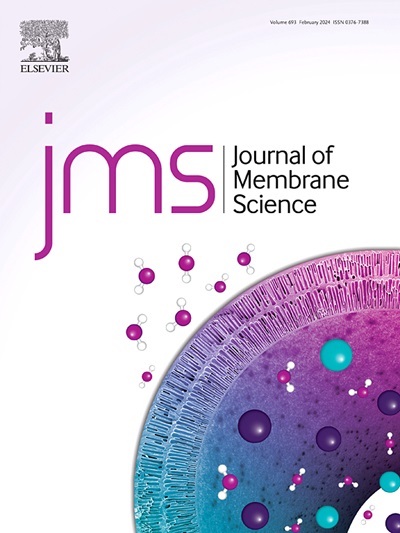Drying polymer membranes for preservation: a review
IF 8.4
1区 工程技术
Q1 ENGINEERING, CHEMICAL
引用次数: 0
Abstract
Preservation is essential to safeguard the performance and structural integrity of membranes post-preparation i.e., during module assembly, transport, and storage in industrial-scale membrane manufacturing. This review synthesises insights from scientific literature, commercial datasheets and patents to identify the most promising preservation procedures for industrial membrane production. First, membrane drying is highlighted as a more efficient route over wet membrane preservation due to easier membrane handling and transport, avoiding the need for biocides while ensuring optimal membrane-adhesive compatibility. However, pore collapse and membrane embrittlement occur during membrane drying, deteriorating respectively filtration performance and membrane integrity. Second, a fundamental understanding of membrane drying is established in which the pore collapse model is revisited to correct the definition of capillary force and account for the surface tension force. Third, three methods for dry preservation are critically reviewed i.e., solvent exchange, use of pore preserving agents (PPAs), and freeze-drying. PPAs combine the most attractive properties as they best preserve the membrane performance, offset brittleness, enable the most straightforward application, are the greenest option, and impose the lowest cost, hence justifying their position as state-of-the-art preservation technique. Finally, potential shortcomings of current preservation procedures are identified through a survey among a selection of membrane industry professionals, revealing long-term preservation stability and waste reduction as important areas of interest which should be addressed in future research.
用于保存的干燥聚合物膜:综述
在工业规模的膜制造中,在组件组装、运输和储存过程中,保存对于保护膜制备后的性能和结构完整性至关重要。本综述综合了来自科学文献、商业数据表和专利的见解,以确定工业膜生产中最有前途的保存程序。首先,由于膜处理和运输更容易,膜干燥被强调为比湿膜保存更有效的途径,避免了对杀菌剂的需要,同时确保了最佳的膜粘合剂相容性。然而,在干燥过程中会发生孔隙塌陷和膜脆,分别破坏过滤性能和膜的完整性。其次,建立了对膜干燥的基本理解,其中重新审视了孔崩溃模型,以纠正毛细力的定义并考虑表面张力。第三,评述了干燥保存的三种方法,即溶剂交换、孔隙保鲜剂(PPAs)的使用和冷冻干燥。ppa结合了最吸引人的特性,因为它们最好地保留了膜的性能,抵消了脆性,实现了最直接的应用,是最环保的选择,并且成本最低,因此证明了它们作为最先进的保存技术的地位。最后,通过对膜工业专业人员的调查,确定了当前保存程序的潜在缺陷,揭示了长期保存稳定性和减少浪费是未来研究中应该解决的重要领域。
本文章由计算机程序翻译,如有差异,请以英文原文为准。
求助全文
约1分钟内获得全文
求助全文
来源期刊

Journal of Membrane Science
工程技术-高分子科学
CiteScore
17.10
自引率
17.90%
发文量
1031
审稿时长
2.5 months
期刊介绍:
The Journal of Membrane Science is a publication that focuses on membrane systems and is aimed at academic and industrial chemists, chemical engineers, materials scientists, and membranologists. It publishes original research and reviews on various aspects of membrane transport, membrane formation/structure, fouling, module/process design, and processes/applications. The journal primarily focuses on the structure, function, and performance of non-biological membranes but also includes papers that relate to biological membranes. The Journal of Membrane Science publishes Full Text Papers, State-of-the-Art Reviews, Letters to the Editor, and Perspectives.
 求助内容:
求助内容: 应助结果提醒方式:
应助结果提醒方式:


